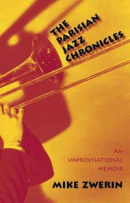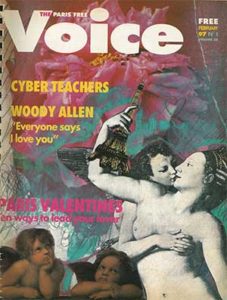Fifty years ago this month, Paris was swarming with the task of recovery – material and psychic. The spring of 1947 brought with it a huge wave of displaced Europeans, and Paris emerged as a “plaque tournante” for a battered continent finding its bearings. In the crowded streets around the Gare Saint-Lazare one heard Polish, Hungarian, Serbo-Croatian. The little hotels were stuffed with people with tattered suitcases, unpronounceable names, and small wads of US dollars and perhaps a few pieces of gold sewn into threadbare overcoats. Many handed over everything they owned for a visa to a far-off country, Cuba or Venezuela, Canada or the United States, the promise of a new start. Many stayed, dug in, opened little shops and became part of France’s merchant class. Others battled to gain passage on a Salvation Army charter boat that left from Le Havre and pulled into the Hudson River two weeks later. Continue reading “Remembering Paris in 1947”
Montmartre, Pigalle and La Chapelle
 Crime and the passion of social ideas; anarchists and artists; sex, drugs, rock ‘n’roll and working class heroes … Paris’ 18th arrondissement has seen it all. Its history tells the tale of some of the major social forces shaping life in this city. From the Paris Commune to the struggles of Paris’ 19th century working class to last year’s “sans papiers” occupation of the district’s Saint-Bernard church, the18th has been a crucible of political, social and artistic ferment. Continue reading “Montmartre, Pigalle and La Chapelle”
Crime and the passion of social ideas; anarchists and artists; sex, drugs, rock ‘n’roll and working class heroes … Paris’ 18th arrondissement has seen it all. Its history tells the tale of some of the major social forces shaping life in this city. From the Paris Commune to the struggles of Paris’ 19th century working class to last year’s “sans papiers” occupation of the district’s Saint-Bernard church, the18th has been a crucible of political, social and artistic ferment. Continue reading “Montmartre, Pigalle and La Chapelle”
Tattoo Art Revisited
For many the word “tattoo” conjures up images of black-leather-clad bikers straddling Harley-Davidsons or sleazy waterfront saloons where drunken sailors have hearts and mermaids tattooed on their biceps. Very few people would actually consider tattooing an art form. Yet it qualifies as one of humankind’s oldest artistic expressions. Two fine current exhibits feature decorative body art. Contemporary artist Antoine Tzapoff studied Indian dance rites in Mexico, resulting in a superb series of 25 documentary paintings on view at the Maison de l’Amérique Latine. The Marquesan exhibition at the Musée de l’Homme highlights magic rites and the extraordinary nature of Marquesan tattoo designs, which cover large areas of the body. Continue reading “Tattoo Art Revisited”
Will Staying in France Help my Career?
Q: I came to France over a year ago to study French literature on a junior year abroad program. I’ve been studying on my own and am officially on leave from my university in the States. I’d like to specialize in international relations in graduate school and become a diplomat. At the same time, I’m really more interested in literature than anything else, and I’d like to stay here for at least another six months. I feel that living here is the best way to give myself time to think about the future, but my parents are pressuring me to go home. Do you think that staying here can help me with my career plans? Continue reading “Will Staying in France Help my Career?”
Living in Paris and Other Fantasies
When asked in a recent survey to name their number one fantasy, most Americans polled did not reply “being president of the United States” or “writing the great American novel.” The number one fantasy was, mais oui, our present reality – “living in Paris.”
Biker Friendly Paris
This spring, the city of Paris will start work on the second phase of a project to complete 100 kilometers of bicycle paths that project supporters say will make every arrondissement biker-friendly.
Mike Zwerin’s Two Hats
 With his trademark hat and cigarette, Mike Zwerin is a recognizable figure in any Paris jazz club. In fact Zwerin wears two hats, as a trombonist and as a columnist for the International Herald Tribune. We met recently in his comfortable home in the 11th arrondissement to discuss both “chapeaux.” Is it tough living a double life? “It’s not quite a double life because both jobs involve music. But it is very hard to mix the two. If I go to play at a festival, it never crosses my mind to do any interviews on the side. I’m there strictly as a musician.”
With his trademark hat and cigarette, Mike Zwerin is a recognizable figure in any Paris jazz club. In fact Zwerin wears two hats, as a trombonist and as a columnist for the International Herald Tribune. We met recently in his comfortable home in the 11th arrondissement to discuss both “chapeaux.” Is it tough living a double life? “It’s not quite a double life because both jobs involve music. But it is very hard to mix the two. If I go to play at a festival, it never crosses my mind to do any interviews on the side. I’m there strictly as a musician.”
Language Teaching Enters Cyber Age
Instead of sitting in front of a teacher, more and more foreign language students are opting to sit in front of a computer. In tough economic times, it makes sense. Students are finding that high technology is a low-cost alternative to language schools. Continue reading “Language Teaching Enters Cyber Age”
Eric Watson’s Jazz Flashbacks
The evening of the Fête de la Musique, pianist Eric Watson was surveying the crowds from the balcony of his Marais apartment when he had an epiphany. “I suddenly flashbacked to the ’60s and ’70s. I felt something was coming; things were finally changing … ” He’s talking about music and the way it’s offered to the public. And he’s talking about the conservatism of the ’90s. “In the ’70s you could deal with Cecil Taylor because of the dope.” He shrugs. “People don’t have that anymore … ” Ergo, they don’t deal with Cecil anymore. Instead they have to deal with being told “by people like Wynton what jazz is. What I want to see more of is truly crazy musicians.” And he’s ready to be one of them? “Absolutely.”
A Valentine with the Midas Touch
Okay, fellas, it’s time to think about making an impression on Valentine’s Day. You can do like every other guy in town and take the love of your life flowers. Or, you can score lots of brownie points by offering her a gift of the gods that’s 18 karat gold. Continue reading “A Valentine with the Midas Touch”
A Woody Allen in Paris
 We knew he could play the clarinet, write and direct like nobody’s business, act a mean nebbish, ignite misguided controversy and woo quirky and/or much younger women. But what most people – including the nation’s professional film critics and his Paris publicist – never suspected about Woody Allen is: He speaks French.
We knew he could play the clarinet, write and direct like nobody’s business, act a mean nebbish, ignite misguided controversy and woo quirky and/or much younger women. But what most people – including the nation’s professional film critics and his Paris publicist – never suspected about Woody Allen is: He speaks French.

